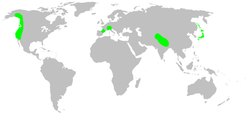Pimoidae
Pimoidae is a small family of araneomorph spiders first described by J. Wunderlich in 1986.[1] It contains 37 species in four genera and is monophyletic.[2] It is closely related to the Linyphiidae,[3] and is sometimes used as a synonym for that family.[4]
| Pimoidae | |
|---|---|
| Scientific classification | |
| Kingdom: | Animalia |
| Phylum: | Arthropoda |
| Subphylum: | Chelicerata |
| Class: | Arachnida |
| Order: | Araneae |
| Infraorder: | Araneomorphae |
| Family: | Pimoidae Wunderlich, 1986 |
| Diversity | |
| 4 genera, 42 species | |
 | |
The species Pimoa cthulhu, described by Gustavo Hormiga in 1994, is named for Howard Phillips Lovecraft's mythological deity Cthulhu.[3]
Distribution
Pimoidae forms a relictual group along the western coast of North America, Europe (Alps, Apennines and Cantabrian Mountains of northern Spain) and the Himalayas. This makes a holarctic predecessor probable. In 2003, a species was found in Japan.
Genera
As of April 2019, the World Spider Catalog accepts the following genera:[5]
Nanoa Hormiga, Buckle & Scharff, 2005
- Nanoa enana Hormiga, Buckle & Scharff, 2005 — USA
Putaoa Hormiga & Tu, 2008 — China
- Putaoa huaping Hormiga & Tu, 2008 — China
- Putaoa megacantha (Xu & Li, 2007) — China
- Putaoa seediq Hormiga & Dimitrov, 2017 — Taiwan
Weintrauboa Hormiga, 2003 — China, Japan, Russia
- Weintrauboa chikunii (Oi, 1979) — Japan
- Weintrauboa contortipes (Karsch, 1881) — Russia, Japan
- Weintrauboa insularis (Saito, 1935) — Russia, Japan
- Weintrauboa plana Xu & Li, 2009 — China
- Weintrauboa pollex Xu & Li, 2009 — China
- Weintrauboa yele Hormiga, 2008 — China
- Weintrauboa yunnan Yang, Zhu & Song, 2006 — China
Pimoa Chamberlin & Ivie, 1943 — North America, Asia, Europe
- Pimoa altioculata (Keyserling, 1886) — USA, Canada
- Pimoa anatolica Hormiga, 1994 — China
- Pimoa breuili (Fage, 1931) — Spain
- Pimoa breviata Chamberlin & Ivie, 1943 — USA
- Pimoa clavata Xu & Li, 2007 — China
- Pimoa crispa (Fage, 1946) — India
- Pimoa cthulhu Hormiga, 1994 — USA
- Pimoa curvata Chamberlin & Ivie, 1943 — USA
- Pimoa delphinica Mammola, Hormiga & Isaia, 2016 — Italy
- Pimoa edenticulata Hormiga, 1994 — USA
- Pimoa gandhii Hormiga, 1994 — India
- Pimoa graphitica Mammola, Hormiga & Isaia, 2016 — Italy, France
- Pimoa haden Chamberlin & Ivie, 1943 — USA
- Pimoa hespera (Gertsch & Ivie, 1936) — USA
- Pimoa indiscreta Hormiga, 1994 — India
- Pimoa jellisoni (Gertsch & Ivie, 1936) — USA
- Pimoa lata Xu & Li, 2009 — China
- Pimoa laurae Hormiga, 1994 — USA
- Pimoa lihengae Griswold, Long & Hormiga, 1999 — China
- Pimoa mephitis Hormiga, 1994 — USA
- Pimoa mono Hormiga, 1994 — USA
- Pimoa nematoides Hormiga, 1994 — Nepal
- Pimoa petita Hormiga, 1994 — USA
- Pimoa reniformis Xu & Li, 2007 — China
- Pimoa rupicola (Simon, 1884) — France, Italy
- Pimoa sinuosa Hormiga, 1994 — Nepal
- Pimoa tehama Hormiga & Lew, 2014 — USA
- Pimoa thaleri Trotta, 2009 — India
- Pimoa trifurcata Xu & Li, 2007 — China
- Pimoa vera Gertsch, 1951 — USA
See also
References
- Wunderlich, J. (1986). Spinnenfauna gestern und heute: Fossile Spinnen in Bernstein und ihre heute lebenden Verwandten.
- Hormiga, Gustavo (2003). "Weintrauboa, a new genus of pimoid spiders from Japan and adjacent islands, with comments on the monophyly and diagnosis of the family Pimoidae and the genus Pimoa (Araneoidea, Araneae)" (PDF). Zoological Journal of the Linnean Society. 139: 261–281.
- Hormiga, Gustavo (1994). "A Revision and Cladistic Analysis of the Spider Family Pimoidae (Araneoidea: Araneae)". Smithsonian Contributions to Zoology. 549: 533–542.
- Murphy, J. A.; Roberts, M. J. (2015). Spider families of the world and their spinnerets. British Arachnological Society. ISBN 978-0950009377.
- "Family: Pimoidae Wunderlich, 1986". World Spider Catalog. Natural History Museum Bern. Retrieved 2019-04-23.
Resource Links
- Pimoidae : Pimoidae page on Tree of Life Web Project.
| Wikispecies has information related to Pimoidae |